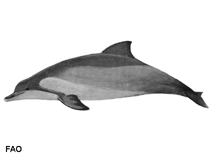Sotalia fluviatilis (Gervais & Deville, 1853)
Tucuxi| Native range | All suitable habitat | Point map | Year 2050 |

|
| This map was computer-generated and has not yet been reviewed. |
| Sotalia fluviatilis AquaMaps Data sources: GBIF OBIS |
Classification / Names Common names | Synonyms | CoL | ITIS | WoRMS
Mammalia | Cetartiodactyla | Delphinidae
Environment: milieu / climate zone / depth range / distribution range Ecology
Pelagic-neritic; freshwater. Tropical; 17°N - 90°S, 180°W - 180°E
Distribution Countries | FAO areas | Ecosystems | Occurrences | Introductions
Western Atlantic, Southeast Pacific and South America Inland Waters: Sotalia fluviatilis fluviatilis: Freshwater, Amazon River (Ref. 1522).
Length at first maturity / Size / Weight / Age
Maturity: Lm ? range ? - ? cm Max length : 210 cm TL male/unsexed; (Ref. 1394); max. published weight: 40.0 kg (Ref. 1394)
Found mostly nearshore and in estuaries. The riverine species feeds on a wide variety of fish, mostly small schooling species and the coastal species consume pelagic and demersal fish and cephalopods. Maximum length: coastal, 210 cm; riverine, 160 cm (Ref. 1394).
Life cycle and mating behavior Maturity | Reproduction | Spawning | Eggs | Fecundity | Larvae
Main reference
References | Coordinator | Collaborators
Jefferson, T.A., S. Leatherwood and M.A. Webber. 1993. (Ref. 1394)
IUCN Red List Status (Ref. 130435: Version 2024-1)
CITES status (Ref. 108899)
Appendix I: International trade banned
CMS (Ref. 116361)
Appendix II: Migratory species conserved through agreements
Threat to humans
Human uses
Fisheries: commercial
FAO - Fisheries: landings, species profile | FishSource | Sea Around Us
Tools
More information
Trophic Ecology
Ecology
Population dynamics
Life cycle
Distribution
Human Related
Aquaculture profile
Stamps, Coins Misc.
Stamps, Coins Misc.
Outreach
Taxonomy
References
Internet sources
BHL | BOLD Systems | CISTI | DiscoverLife | FAO(Fisheries: species profile; publication : search) | Fishipedia | GenBank (genome, nucleotide) | GloBI | Gomexsi | Google Books | Google Scholar | Google | PubMed | Tree of Life | Wikipedia (Go, Search) | Zoological Record
Estimates based on models
Preferred temperature
(Ref. 115969): 24.4 - 28.1, mean 27.3 (based on 286 cells).
Resilience
(Ref. 69278):
High, minimum population doubling time less than 15 months (K=0.31).
Price category
(Ref. 80766):
Unknown.



